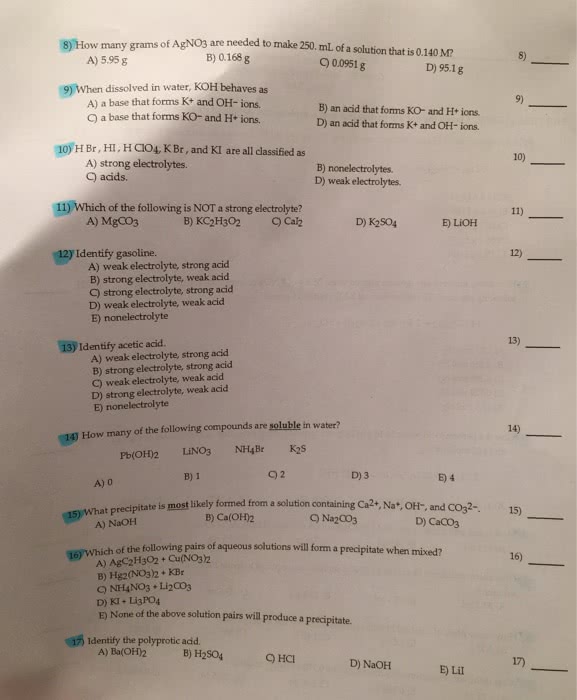CHEM 115 Chapter Notes - Chapter 4: Fluorine, Sodium Hydroxide, Sodium Chloride
51 views4 pages
5 Nov 2017
School
Department
Course
Professor
Document Summary
Substance that does not form ions in solution. Solutes that exist in solution completely or nearly completely as ions. Exist in solution mostly in form of neutral molecules with only a small fraction that form ions. , ch3coo-, nh4: all no3, cl-, br-, i- (except ag+, hg2, so4. Insoluble: s2- and oh- (except ca2+, sr2+, ba2+, alkali metal cations and nh4, co3. Cations and anions switch when forming products. Ax + by ay + bx. Pb (no3)2(aq) + 2 ki(aq) pbi2(s) + 2kno3(aq) (aq) + 2 k+(aq) + 2 i- (aq) pbi2(s) + 2 k+(aq) + 2 no3. Pb2+(aq) + 2 i- (aq) pbi2(s) (aq) appear on both sides of equation, cancel each other out, called spectator ions. Strong bases are alkali metals, calcium, strontium, barium. When acid and bases are mixed in solution, neutralization occurs. Products have no characteristics of an acidic or basic solution.
Get access
Grade+20% off
$8 USD/m$10 USD/m
Billed $96 USD annually

Homework Help
Study Guides
Textbook Solutions
Class Notes
Textbook Notes
Booster Class
40 Verified Answers
Class+
$8 USD/m
Billed $96 USD annually

Homework Help
Study Guides
Textbook Solutions
Class Notes
Textbook Notes
Booster Class
30 Verified Answers
Related textbook solutions
Chemistry: Structure and Properties
2 Edition,
Tro
ISBN: 9780134293936
Basic Chemistry
5 Edition,
Timberlake
ISBN: 9780134138046
Principles of Chemistry Molecular Approach
4th Edition,
Tro
ISBN: 9780134112831
Principles of Chemistry Molecular Approach
3rd Edition, 2014
Tro
ISBN: 9780321971944
Chemistry: Structure and Properties
2nd Edition,
Tro
ISBN: 9780134293936
Chemistry: A Molecular Approach
3rd Edition,
Tro
ISBN: 9780321809247
Chemistry: A Molecular Approach
5th Edition,
Tro
ISBN: 9780134874371
Principles of Chemistry: A Molecular Approach
4th Edition,
Tro
ISBN: 9780134895741
Chemistry: The Central Science
14th Edition, 2017
Brown
ISBN: 9780134414232
